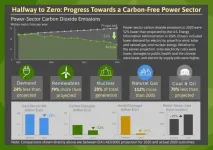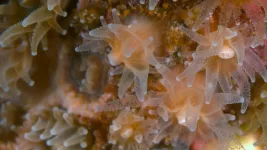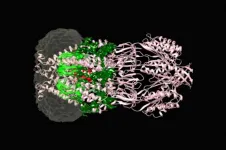Joyful screams perceived more strongly than screams of fear or anger
2021-04-13
(Press-News.org) Screaming can save lives. Non-human primates and other mammalian species frequently use scream-like calls when embroiled in social conflicts or to signal the presence of predators and other threats. While humans also scream to signal danger or communicate aggression, they scream when experiencing strong emotions such as despair or joy as well. However, past studies on this topic have largely focused on alarming fear screams.
Humans respond to positive screams more quickly and with higher sensitivity
In a new study, a team at the University of Zurich Department of Psychology led by Sascha Frühholz investigated the meaning behind the full spectrum of human scream calls. The results revealed six emotionally distinct types of scream calls indicating pain, anger, fear, pleasure, sadness and joy. "We were surprised by the fact that listeners responded more quickly and accurately, and with a higher neural sensitivity, to non-alarming and positive scream calls than to alarming screams," says Frühholz.
Cognitive processing of joyful screams is more efficient
The research team carried out four experiments for their study. Twelve participants were asked to vocalize positive and negative screams that might be elicited by various situations. A different group of individuals rated the emotional nature of the screams and classified them into different categories. While participants listened to the screams, their brain activity underwent functional magnetic resonance imaging (fMRI) to monitor how they perceived, recognized, processed and categorized the sounds. "The frontal, auditory and limbic brain regions showed much more activity and neural connectivity when hearing non-alarm screams than when processing alarm scream calls," explains Frühholz.
More complex social environments have reshuffled neurocognitive priorities
It was previously assumed that human and primate cognitive systems were specially tailored for recognizing threat and danger signals in the form of screams. In contrast to primates and other animal species, however, human scream calls seem to have become more diversified over the course of human evolution - something that Frühholz considers to be a big evolutionary leap. "It's highly possible that only humans scream to signal positive emotions like great joy or pleasure. And unlike with alarm calls, positive screams have become increasingly important over time," he says. Researchers suggest that this may be due to the communicative demands brought about by humans' increasingly complex social environments.
INFORMATION:
ELSE PRESS RELEASES FROM THIS DATE:
2021-04-13
Living near a hazardous waste or Superfund site could cut your life short by about a year, reports Hanadi S. Rifai, John and Rebecca Moores Professor of Civil and Environmental Engineering at the University of Houston. The study, published in Nature Communications and based on evaluation of 65,226 census tracts from the 2018 Census, is the first nationwide review of all hazardous waste sites and not just the 1,300 sites on the national priority list managed by the federal government.
The analysis shows a decrease of more than two months in life expectancy for those living near a Superfund site. When coupled with high disadvantage of sociodemographic factors like age, sex, marital status and income, the decrease could be nearly 15 months, ...
2021-04-13
A group of researchers led by Brazilians has used an innovative model to map gaps in the Amazon rainforest and identify factors that contribute to tree mortality. Water stress, soil fertility, and anthropic forest degradation have the most influence on gap dynamics in the world's largest and most biodiverse tropical rainforest, according to an article on the study published in Scientific Reports.
Forest gaps are most frequent in the areas with the highest levels of soil fertility, possibly because the abundance of organic material drives faster tree growth and shorter life cycles.
The main method of data collection ...
2021-04-13
The electronic properties of solid materials are highly dependent on crystal structures and their dimensionalities (i.e., whether the crystals have predominantly 2D or 3D structures). As Professor Takayoshi Katase of Tokyo Institute of Technology notes, this fact has an important corollary: "If the crystal structure dimensionality can be switched reversibly in the same material, a drastic property change may be controllable." This insight led Prof. Katase and his research team at Tokyo Institute of Technology, in partnership with collaborators at Osaka University and National Institute for Materials Science, to embark on research into the possibility of switching the crystal structure dimensionality of a lead-tin-selenide alloy semiconductor. Their results appear in a paper published ...
2021-04-13
A study carried out by the University of Granada indicates that smoking cannabis significantly alters key visual functions, such as visual acuity, contrast sensitivity, three-dimensional vision (stereopsis), the ability to focus, and glare sensitivity
Yet, more than 90% of users believe that using cannabis has no effect on their vision, or only a slight effect
A group of researchers from the Department of Optics of the University of Granada (UGR) has studied the effects of smoking cannabis on various visual parameters compared to the effect that the users themselves perceive the drug to have on their vision.
This study, led by Carolina Ortiz Herrera and Rosario González Anera, has been published in the journal Scientific Reports. Its main author, Sonia Ortiz Peregrina, explains that ...
2021-04-13
Concerns about climate change are driving a growing number of states, utilities, and corporations to set the goal of zeroing out power-sector carbon emissions. To date 17 states plus Washington, D.C. and Puerto Rico have adopted laws or executive orders to achieve 100% carbon-free electricity in the next couple of decades. Additionally, 46 U.S. utilities have pledged to go carbon free no later than 2050. Altogether, these goals cover about half of the U.S. population and economy.
These are ambitious targets, but a new look at the past 15 years in the electricity sector shows that large reductions in emissions are possible.
New research from the Department of Energy's Lawrence ...
2021-04-13
As the Rhode Island legislature considers designating the Northern Star Coral an official state emblem, researchers are finding that studying this local creature's recovery from a laboratory-induced stressor could help better understand how to protect endangered tropical corals.
A new study published today in mSystems, a journal of the American Society for Microbiology, investigates antibiotic-induced disturbance of the coral (Astrangia poculata) and shows that antibiotic exposure significantly altered the composition of the coral's mucus bacterial microbiome, but that all the treated corals recovered ...
2021-04-13
A new study published in Elementa by researchers at the University of California, Santa Cruz and NOAA examines traditional aspects of seafood sustainability alongside greenhouse gas emissions to better understand the "carbon footprint" of U.S. tuna fisheries.
Fisheries in the United States are among the best managed in the world, thanks to ongoing efforts to fish selectively, end overfishing, and rebuild fish stocks. But climate change could bring dramatic changes in the marine environment that threaten seafood productivity and sustainability. That's one reason why researchers ...
2021-04-13
Physicists from Swansea University are part of an international research collaboration which has identified a new technique for testing the quality of quantum correlations.
Quantum computers run their algorithms on large quantum systems of many parts, called qubits, by creating quantum correlations across all of them. It is important to verify that the actual computation procedures lead to quantum correlations of desired quality.
However, carrying out these checks is resource-intensive as the number of tests required grows exponentially with the number of qubits involved.
Researchers from the College of Science, working with colleagues from Spain ...
2021-04-13
Biomedical scientists are increasingly using deconvolution methods, those used to computationally analyze the composition of complex mixtures of cells. One of their challenges is to select one method that is appropriate for their experimental conditions among nearly 50 available.
To help with method selection, researchers at Baylor College of Medicine and the Jan and Dan Duncan Neurological Research Institute at Texas Children's Hospital have extensively evaluated 11 deconvolution methods that are based on RNA-sequencing (RNA-seq) data analysis, determining each method's ...
2021-04-13
Almost all bacteria rely on the same emergency valves--protein channels that pop open under pressure, releasing a deluge of cell contents. It is a last-ditch effort, a failsafe that prevents bacteria from exploding and dying when stretched to the limit. If we understood how those protein channels worked, antibiotic drugs could be designed to open them on demand, draining a bacterium of its nutrients by exploiting a floodgate common to many species.
But these channels are tricky to operate in the lab. And how precisely they open and close, passing through a sub-conducting state and ending in a desensitized state under the influence of mechanical forces, remains poorly understood. Now, new research from ...
LAST 30 PRESS RELEASES:
[Press-News.org] Joyful screams perceived more strongly than screams of fear or anger






